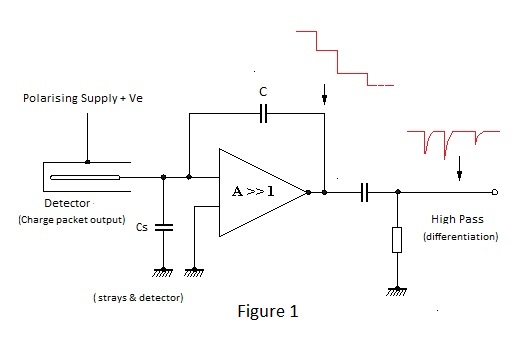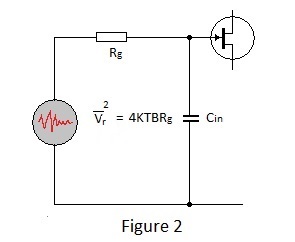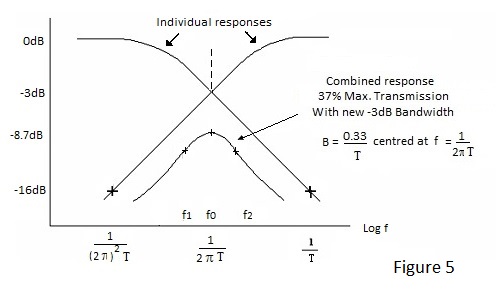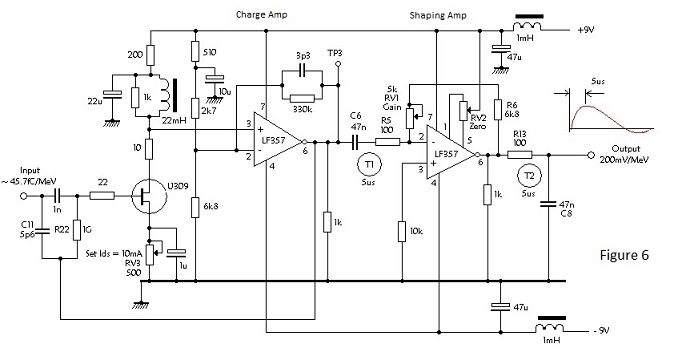
Back to Homepage & Index
This Page - Nuclear Pulse Amplification
All nuclear event detectors produce signals in the form of packets of charge. For purely event detectors, e.g. Geiger-Muller counters, the charge produced is usually large enough to render its conversion to a form suitable for driving a counting circuit a simple matter but for spectrometric detectors, where the magnitude of the charge packet is proportional to the kinetic energy of the cause event, it is usually very small and requires careful amplification before application to amplitude selective counting circuits. Detectors in this latter category include solid state and gas proportional detectors and, to a lesser extent, scintillation detectors. It is amplification of signals from these devices which forms the subject of this note.
Analogue signal processing circuits normally work with a voltage signals with an amplitude range extending from zero to close to supply rail voltage. It is therefore necessary to convert detector charge packets to voltage pulses and then to amplify these to a level suitable for processing. Because the signals at the early stages of conversion and amplification are very small, it is essential to minimise circuit noise if individual pulse amplitudes are to be resolved with precision. The circuit which converts charge to voltage is known as a charge sensitive amplifier (CSA) or sometimes simply as a charge amplifier.

If, as invariably the case, the amplifiers open loop gain 'A' is much greater than unity, the voltage excursion at the input terminal is very small and a negligible proportion of charge q is diverted into charging of the stray capacitance Cs or to ground via any parallel leakage resistance.Because of the minute voltage movement at the input terminal, the amplifier is said to have a virtual ground input - a property common to most inverting operational amplifier circuits.
Thus the arrival of a detected positive charge at the input terminal causes a negative voltage step to occur at the output terminal of the amplifier and, unless the feedback capacitor C has a parallel resistance path to discharge it, this voltage remains static until another detected charge causes the output to step further; a series of detected events creating a staircase until the output of the amplifier is limited by the negative supply.
Voltage steps are of little use for signal processing and it is necessary to convert them to pulses by applying the amplifier output to a differentiating network (high pass filter) as is also shown in Figure 1. The rise time of the steps represent the charge collection time; a few nanoseconds for solid state and scintillation detectors and microseconds for gas ionisation detectors.
In order to obtain full signal transfer the differentiation time constant must exceed the charge collection time, however it must be small enough to prevent pulse pile-up at a maximum specified counting rate. Factors governing the choice of time constant are discussed later in this note.
It is obvious from the foregoing discussion that, unless the charge on capacitor C is leaked away by shunt resistance, an amplifier as depicted in Figure 1 would sooner or later become paralysed dependent upon the rate and magnitude of detected events. This resistance could be small enough to provide the differentiation mentioned in the preceding paragraph - and often is with scintillation detectors - but in the case of solid state or gas ionisation detectors, the reader is asked for the moment to accept that its value should be as high as possible and that differentiation should be applied later in the path of signal amplification.
To avoid paralysis in the amplifier depicted, the leakage reaistance R must be less than the negative supply voltage divided by the product of the mean detected charge and the maximum specified count rate. I.e. the maximum leakage current must exceed the current resulting from input charges arriving at the maximum specified detection rate.
For example assume a silicon alpha particle detector required to respond to 5MeV particles from activity producing up to 10,000 detections per second. If the mean energy to release an ion pair in silicon is 3.5 eV, each alpha particle detected will release approximately 1.43 million electron charges or 0.228 pico Coulombs. Thus, at 10,000 detected events per second, the effective signal current detector is 2.28 nA. Assume also that the amplifier output can reach - 5V before being limited by proximity to the negative supply voltage. The value of R must not exceed 5/22.8 x GΩ or approximately 2GΩ and a value of 1GΩ would probably be specified to be safe.
Consider now a value for C; if this is too great the voltage steps will be so small as to make voltage amplification difficult due to the noise introduced by the voltage amplifier and if it is too small, its true value will be indeterminate due to the influence of stray capacitance. A value of 5 to 6pF is probably a fair compromise.
Assume C = 5pF, then the voltage step or pulse for our 5MeV event will be q/C = 0.228/5 = 46mV approximately.At first sight this appears to be a 'healthy' signal relative to amplifier noise - being of the same order as the input signals to audio amplifiers - and, in comparison with, for example, the signal from a gas proportional counter detecting 20keV X-ray photons, it is. However, as will evolve in due course, parameters such as detector capacitance have a significant effect upon signal to noise ratio and amplifier noise can be a problem with solid state alpha detectors particularly when the requirement is to resolve particle energy with precision.
Let us now consider noise and how it may be minimised:- Noise is usually a problem in the first stage of a pulse amplifier, after which, with good design, the amplified signal is relatively large in comparison with noise introduced in successive stages.
There are three assessable sources of noise in amplifying devices and one which is which is less well understood. The assessable sources are: a) Thermal noise produced by the input resistor, b) Shot noise produced by current flowing in the input circuit (including detector leakage) and c) Thermal noise in the controlled current path i.e. the channel of an fet, the cathode to anode of a thermionic valve or the emitter to collector of a bipolar transistor. The fourth source, flicker or 1/f noise is usually only a problem with direct coupled amplifiers where it may be considered as a form of working point drift.
In this note discussion of these sources is limited to simplified statements of magnitude and effect. A detailed explanation of how they are derived is given in reference [1] which is recommended foundation reading for anyone interested in the application of electronics to nuclear physics.
A noise signal is alternating and random and thus it is not possible to define as a singular voltage or current. It is therefore expressed in a manner which reflects the power it delivers to a load resistance; either as a mean squared voltage or current or, perhaps more aptly, the root of these values.
The mean squared noise voltage is equal to 4KTBR
Where K is Boltzmann's constant
T is Kelvin Temperature
R is resistance (Ohms)
B is the observed frequency band
Thus noise increases with temperature, resistance and the frequency band and, with regard to the latter, its value will always be the same for equal bands throughout the frequency spectrum; i.e. noise measured in the band 1000Hz to 1100Hz equals that in the band 100Hz to 200Hz. Because of this uniform spectral density, thermal noise is referred to as white noise.
At first sight, the fact that noise increases with resistance does not square with the earlier proposition, that the value of the resistance providing a leakage path for the feedback capacitor C of a charge amplifier should be as large as practicable. However the resistor may be considered as a noise voltage generator, of source impedance equal to its resistance, connected to the input terminal of the amplifier. Therefore the actual noise voltage presented to the input is attenuated by capacitance between the input terminal and ground as shown in Figure 2. This applies equally to resistors in the input signal path (as in the figure) or in the feedback path. Note that this capacitance includes the capacitance of a detector connected to the input terminal in addition to the amplifier input capacitance.
 |
Analysis of this simple circuit to determine the |
|||||||||||||||
which demonstrates, perhaps somewhat surprisingly, that the effective noise signal reduces with increase of the value of resistance. Consider now the second source of noise listed above - current in the input circuit as depicted in Figure 3. |
||||||||||||||||
 |
|
|||||||||||||||
In the figure the value of Rg is large for the reason discussed above and consequently noise currents flow through almost entirely through Cin. Shot noise apparently results from random fluctuations of the electron flow constituting a 'steady' current and consequently it is expressed in terms of noise current:- Thermionic valves (now obsolete) were more satisfactory in this respect but paradoxically mosfets are much less so despite their low input currents compared with jugfets. To assess the effect of current noise upon the voltage driven amplifier it is necessary to derive the mean squared noise voltage which it produces at the gate terminal:- |
||||||||||||||||
|
||||||||||||||||
All content is free to use.








